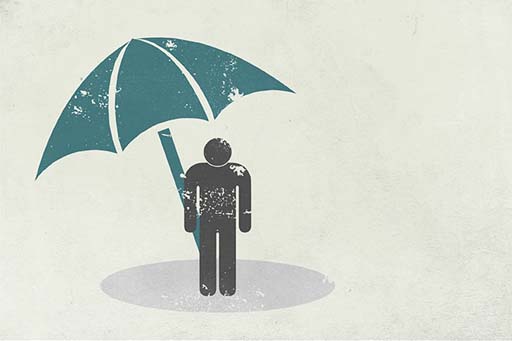8.3 Life insurance and other types of insurance
In this section, you will learn what your options are for life insurance and when it makes sense to buy these products. You will also look at supplementing the cover provided by the state, like NHS cover for medical matters, and also the revolution in pricing of insurance.

Where someone’s income is the major (or sole) part of household income, or their unpaid work is necessary to the care of others, the death of that person would risk making the dependants or co-dependants suffer serious hardship. So protection insurance, such as term life insurance, may be important. However, life insurance may be irrelevant to a single person with no dependants.
Around 40% of all households decide to take out life insurance. Many life insurance products take the form of term insurance, which insures against the financial consequences of death within a specified term of perhaps five, ten or 20 years. You can choose a term that mirrors the length of a large debt such as a mortgage. Mortgage providers often insist on life insurance and for many homeowners it makes sense to have it.
Term insurance can be level term insurance, where the amount covered will remain the same during the whole of the cover term. Or it can be ‘decreasing’ term insurance, when the amount covered decreases over the length of the term. This is typically used to protect against a debt that declines over time such as a repayment mortgage.
There is also a type of term life insurance (called family income benefit) that pays an income rather than a capital sum to family members. You could consider this if you have no substantial debts to cover. It could be used, for instance, to provide an income that replaces that of the person who died, or an income that can be used to buy replacement childcare or elderly care if a parent or a carer dies.
Some life insurance is not for a specified term, but is open-ended, or whole of life, cover. This is rather more expensive than term insurance, and is often used to build up an investment rather than dealing with the consequences of an untimely death. The cost of cover will depend on age and state of health.
Endowment policies, unlike term insurance, build up an investment value and pay out at the end of the term if the policyholder has not died. As you saw in Week 6, these kinds of policy were commonly associated with house purchases. Where the policy was purchased with a mortgage, the insurance cover provided protection against death during the term, while the pay out at the end was intended to be sufficient to clear the outstanding mortgage debt.
However, since endowment policies are stock market-linked investments, there was no guarantee that the policy would grow enough to pay off the mortgage in full. Following controversies over their ‘mis-selling’, and poor stock market performance throughout the 2000s, use of endowment policies for mortgages has been in sharp decline, with under four million policies left in operation by 2010. But endowment policies are still used for insurance-based savings products and bonds.
Some life insurance tips:
- Life insurance can be written ‘in trust’, so that any pay out goes straight to the beneficiary rather than into the deceased’s estate. This avoids the danger of having to pay Inheritance Tax, and avoids delays that can be caused by legal processes.
- The amount of cover you require should be calculated before buying life insurance. This might include paying off debts (including a mortgage), and providing capital from which to produce some income for surviving household members. No one should take the level of cover offered without assessing their personal needs.
- If you wish to take out life insurance you need to think about the possible effect of inflation on the policy – how much is any pay out of capital or income going to be worth in the future?
